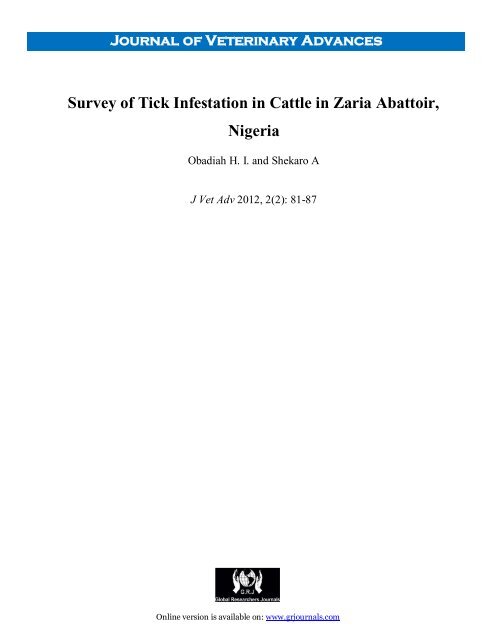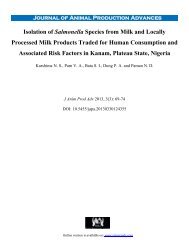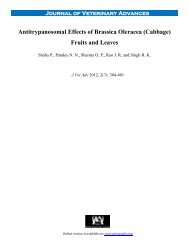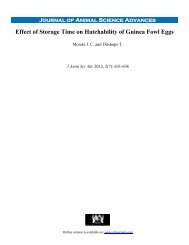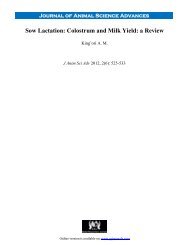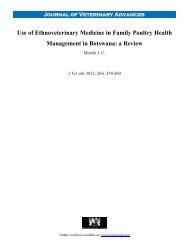PDF Download - Global Researchers Journals
PDF Download - Global Researchers Journals
PDF Download - Global Researchers Journals
You also want an ePaper? Increase the reach of your titles
YUMPU automatically turns print PDFs into web optimized ePapers that Google loves.
Journal of Veterinary Advances<br />
Survey of Tick Infestation in Cattle in Zaria Abattoir,<br />
Nigeria<br />
Obadiah H. I. and Shekaro A<br />
J Vet Adv 2012, 2(2): 81-87<br />
Online version is available on: www.grjournals.com
ISSN: 2251-7685<br />
Abstract<br />
81 J. Vet. Adv., 2012, 2(2):81-87<br />
OBADIAH AND SHEKARO<br />
Survey of Tick Infestation in Cattle in Zaria<br />
Abattoir, Nigeria<br />
*1 Obadiah H. I. and 2 Shekaro A<br />
1 Department of Biological Sciences, Faculty of Science, Ahmadu Bello University, Zaria, Kaduna State<br />
2 National Veterinary Research Institute, Vom, Jos, Plateau State, Nigeria<br />
Nigeria has a high herd of cattle population, majority of which are in the hands of pastoralists. Apart from<br />
the direct effect of tick infestation on animal production and productivity, ticks are inevitably efficient vectors<br />
of many pathogens, like protozoa, viruses, bacteria, and rickettsiae to man and domestic animals. A survey on<br />
ticks (arthropods) was carried out in Zaria abattoir in December 2009. 120 animals were samples, out of which<br />
66 (55 %) were males and 54 (45 %) females. Four species of ticks were collected from three breeds of cattle<br />
and their prevalence showed; Amblyomma variegatum 27 (22.5%) as the commonest, followed by Boophilus<br />
decoloratus, 21 (17. 5%), Hyalomma sp 8 (6.7 %) and Rhipicephalus sanguineus 4(3.3 %). We also noted that<br />
19(15.8%) of the animals examined had skin lesions in addition to ticks infestation. We therefore recommend<br />
in strong term a control of ticks in our environment to prevent spread of diseases and improve animal<br />
production in this region.<br />
Key words: Cattle, ticks, abattoir<br />
* Corresponding author: hagbike@yahoo.com<br />
Received on: 18 Jan 2012<br />
Accepted on: 28 Jan 2012<br />
Online Published on: 01 Feb 2012<br />
Original Article
SURVEY OF TICK INFESTATION IN CATTLE IN ZARIA …<br />
Introduction<br />
Nigeria had a mean cattle population of<br />
13.9million in 1990, of which 11.5million of this<br />
population were kept under pastoral system (Okoli<br />
et al., 2012) and 2.4 million in the villages (Roger,<br />
1999). Furthermore, these cattle were<br />
predominantly zebu, such as, Bunaji (White Fulani),<br />
Rahaji (Red Bororo), Sokoto gudali and others. The<br />
author reported a seasonal change in the relative<br />
proportion of these animals in various ecological<br />
zones of the country.<br />
Apart from trypanosomosis and other disease<br />
agents, ticks also affect the production of animals.<br />
Ticks are obligatory blood-sucking arachnid<br />
arthropods infecting mammals, birds, reptiles and<br />
amphibians. They are vectors of disease agents<br />
(such as babesiosis, cowdriosis, anaplasmosis),<br />
causing anaemia, dermatitis, paralysis, otocariasis,<br />
as well as loss of production (Schmidt and Roberts<br />
1989). Three families of ticks have been identified,<br />
but two of them are well known and of veterinary<br />
importance, Ixodidae (hard ticks) and Argasidae<br />
(soft ticks) (Sonenshine 1991; Luqman et al., 2007).<br />
Once they attach to a host for a blood meal,<br />
they can cause skin irritation and anemia.<br />
According to Radunz (2003), cattle ticks transmit<br />
the organisms that cause tick fever, which is a<br />
serious blood parasite disease of cattle. This disease<br />
can be lethal to susceptible animals, and others may<br />
suffer severe loss of condition. They are vectors of<br />
pathogens, such as Babesia, Theileria, and<br />
Anaplasma spp. to animals in the world (Soulsby,<br />
1982).<br />
Because of the diseases they transmit in<br />
addition to induce paralysis or toxicosis and cause<br />
physical damage to livestock, animals in poor<br />
condition are especially vulnerable (Radunz, 2003).<br />
Previously unexposed cattle become heavily<br />
infested until they build up a degree of resistance.<br />
Bos indicus cattle (tropical breeds) and their crosses<br />
develop a greater degree of resistance than do Bos<br />
taurus (British and European breeds) (Radunz,<br />
2003).<br />
According to Robert et al. (2009), the winter<br />
tick is a one-host species that feeds primarily on<br />
large hoofed animals. The larvae attack host<br />
animals from early October through April, molt to<br />
nymphs on the host, feed and then molt to the adult<br />
stage while still on the host. Both males and females<br />
take a blood meal, mate, and then the engorged<br />
female drop to the ground and lays eggs. Tick<br />
populations on the host get to a peak between late<br />
October and mid-February.<br />
The economic impact of tick infestations is<br />
enormous worldwide. In 1984, the United Nation<br />
Food and Agriculture Organization (FAO)<br />
estimated the global cost of Ixodidae tick infestation<br />
to be US$7.0 billion annually. The one-host tick<br />
Boophilus microplus is reported to have caused<br />
losses of more than US$1.0 billion and US$1.0<br />
million annually in South America and Australia,<br />
respectively (Radostits et al. 2000).<br />
Zaria and it’s environ has a special climate<br />
(Guinea Savannah), with its rainy (range from April<br />
to October) and dry (from November to March)<br />
seasons favorable to agriculture and animal<br />
husbandry (Mortimore, 1970). Many cattle graze in<br />
the pastures and forests, and the probability for<br />
them to be exposed to tick infestation is very high.<br />
However, so far, only few studies have been done<br />
on ticks, particularly encountered at the slaughter<br />
house which is the true picture of those in the field.<br />
The aim of this study was to determine the<br />
frequency of tick infestation in cattle observed in<br />
Zaria abattoir.<br />
Materials and Methods<br />
Study Area<br />
A study of ticks was carried out in Zaria<br />
abattoir. Zaria (11° 3' N; 7° 42' E) is located about<br />
83km North of Kaduna, along the Kaduna-Kano<br />
highway (Mortimore, 1970). Zaria comprises of two<br />
Local Government Areas namely; Zaria and Sabon<br />
Gari. By the existing pattern of settlement, Zaria<br />
urban is composed mainly of four districts namely;<br />
Zaria City, Tudun Wada, Sabon Gari and Samaru.<br />
Zaria is made up of a natural and stable<br />
ecosystem in the Northern Guinea Savannah zone,<br />
with a discontinuous layer of sparsely distributed<br />
short trees followed by relatively continuous layers<br />
of tall, medium and short grasses; rainfall is below<br />
125mm (Mortimore, 1970). Zaria is an old<br />
commercial, administrative and academic town in<br />
Northern Nigeria, but most parts have poor<br />
environmental hygiene as evident by heaps of<br />
refuse dumps coupled with indiscriminate disposal<br />
82 J. Vet. Adv., 2012, 2(2):81-87
of human and animal wastes, even by the side of<br />
streets (Aina, 2002, Unpublished B.Sc. project of<br />
Department of Geography, A.B.U. Zaria).<br />
Sample Collection<br />
120 cattle were randomly selected and<br />
ectoparasites specimen were collected from them.<br />
All parts of the body of cattle were carefully<br />
examined. Using hand gloves, the ticks were<br />
removed from the body of the host with all<br />
necessary precautions to avoid damage to the<br />
mouthparts of the ticks and skin of host. Specimens<br />
collected were put in folded white paper (each<br />
sample/ animal) with little space to allow the ticks<br />
have access to air. The specimen containers were<br />
carefully labeled to indicate: breed of cattle, site of<br />
tick location in the body of the animal and sex of<br />
the animal. The samples collected were then<br />
transported to the Veterinary Entomology<br />
Laboratory, ABU, Zaria and directly preserved in<br />
70 % alcohol before examination.<br />
Morphological identification<br />
The live ticks were placed in petri dish<br />
containing 70% alcohol using forceps and the<br />
samples were examined with low power dissecting<br />
microscope (Nikon, made in Japan) and identified<br />
by using the key of morphological characters as<br />
described by Service (1979).<br />
Statistical Analysis<br />
The data collected were tabulated according to<br />
the number of visits to the abattoir. The students ttest<br />
were used to compare the means, correlation<br />
analysis was also used to compare between types of<br />
ticks and the lesions, the sex and breed of cattle;<br />
using the SPSS version 16.<br />
Results and Discussion<br />
Presented in Tables 1, 2, 3, 4 and 5, about 120<br />
heads of cattle were sampled, out of which 66 (55<br />
%) were males and 54 (45 %) females. Among the<br />
breed in the same population, the White Fulani<br />
breed was the most frequent breed with 90 (75 %),<br />
followed by Red Bororo, 20 (16.7 %) and Sokoto<br />
Gudali 10 (8.3 %). The result showed that inguinal<br />
region was the most common predilection site for<br />
83 J. Vet. Adv., 2012, 2(2):81-87<br />
OBADIAH AND SHEKARO<br />
the ticks, with 53 (44. 2 %) and the chest had the<br />
least with 5 (4.2 %).<br />
Table 1: Sex variation in with tick infestation<br />
Sex Frequency Prevalence (%)<br />
Male 66 55.0<br />
Female 54 45.0<br />
Total 120 100<br />
Table 2: Breed associated with tick infestation<br />
Breed Frequency Prevalence (%)<br />
White Fulani 90 75.0<br />
Sokoto Gudali 10 8.3<br />
Red Bororo 20 16.7<br />
Total 120 100<br />
Table 3: Predilection site associated with tick infestation<br />
Predilection site Frequency Prevalence (%)<br />
Inguinal 53 44.2<br />
Chest 5 4.2<br />
General body surface 62 51.7<br />
Total 120 100<br />
Table 4: Types of ticks observed in the animals<br />
Type of tick Frequency Prevalence (%)<br />
Amblyoma sp. 27 22.5<br />
Boophilus sp. 21 17.5<br />
Rhipicephalus sp.<br />
Hyalomma sp.<br />
Others<br />
4<br />
8<br />
60<br />
3.3<br />
6.7<br />
50<br />
Total 120 100<br />
Table 5: Lesions observed associated with tick<br />
infestation<br />
Lesion Frequency Prevalence (%)<br />
Present 19 15.8<br />
Absent 202 84.2<br />
Total 120 100<br />
Four types of ticks were identified:<br />
Amblyomma variegatum, Boophilus decoloratus,<br />
Rhipicephalus sanguineus, and Hyalomma sp. The<br />
frequency of occurrence in the study showed that<br />
Amblyomma variegatum 27 (22. 5 %) was the<br />
commonest ticks observed in cattle in Zaria abattoir<br />
followed by Boophilus decoloratus, 21 (17. 5),<br />
Hyalomma, 8 (6.7 %) and Rhipicephalus<br />
sanguineus 4 (3.3 %). In addition, 19 animals had<br />
skin lesions similar to that described for<br />
Dermatophilos infection while 101 animals had<br />
none. Some of these lesions were associated with<br />
ticks’ infestations, while some were not (Table 4).
Ticks identifications (External morphology)<br />
The external morphology of the four genuses of<br />
ticks were examined and identified based on the<br />
descriptive terminology of Service (1979) and<br />
lecture notes of Agbede (2009, Advanced<br />
Entomology course for postgraduate students,<br />
2008/09 session). The body had four pairs of legs<br />
which were segmented (coxa, trochanter, femur,<br />
genu, tibia and tarsus) and terminated in a pair of<br />
claws. The ticks were observed to have the<br />
capitulum (where the head and mouthparts are<br />
located) exposed and easily visible from the top.<br />
The upper side of their body bears a distinctly<br />
sclerotized shield or scutum. This structure covered<br />
most of the upper body surface in the male tick, but<br />
was restricted to a much smaller area (immediately<br />
behind the capitulum) in the female.<br />
The engorged female had her abdomen<br />
increased to many times its normal dimensions and<br />
the scutum appeared to be extremely small in<br />
relation to the body size. Male ticks were not so<br />
large when engorged like the female. These features<br />
were presented as documented in the text by Service<br />
(1979).<br />
Ticks and tick-borne diseases affect animals<br />
and human health worldwide and are the cause of<br />
significant economic losses in livestock. Animal<br />
ticks have been reported from all over the world and<br />
the various species in domestic ruminants have been<br />
identified to include: Amblyomma variegatum,<br />
SURVEY OF TICK INFESTATION IN CATTLE IN ZARIA …<br />
Boophilus decoloratus, Rhipicephalus sanguineus,<br />
and Hyalomma sp and Dermaginatus marginatumas<br />
(Agbede, 2009 Lecture notes for Advance<br />
Entomology course for postgraduate students,<br />
2008/09 session).<br />
In Nigeria, James and Jidayi (2004) had an<br />
investigation on ecto-parasites of livestock from<br />
Maiduguri Metropolitan and its environs and<br />
Nangere in Yobe State. They examined 1,600<br />
camels, 2,200 cattle, 500 sheep, 400 goats, 230 dogs<br />
and 250 pigs for ectoparasites. The results showed<br />
that the species of ticks found were all from the<br />
Family Ixodidae. In addition, in cattle, infestation<br />
with Boophilus decoloratus, Hyalomma tuncatum,<br />
Rhipicephalus sanguineus, Haemaphysalis leachii<br />
and Amblyomma lepidum are predominant in that<br />
order.<br />
Based on the above finding, the most widely<br />
distributed genus in our study was Boophilus<br />
decoloratus, followed by Amblyomma, Hyalomma,<br />
and Rhipicephalus sp in that order. Radunz (2003)<br />
in the same vein reported that Boophilus microplus<br />
was the most serious external parasites of cattle in<br />
the Northern Australia. This tick favors cattle, but<br />
infestations also occur in buffaloes, deer, horse, and<br />
sheep he explained. In Nigeria, Garba et al. (2011)<br />
documented the incidence of ticks like<br />
Rhipicephalus spp 20 (87%) and Boophilus spp 3<br />
(13%) to be associated with the horses.<br />
Contrary to our findings, Durrani and Shakoori<br />
(2009) studied the ecological growth conditions of<br />
cattle ticks in Punjab, Pakistan, out of 120 tick<br />
specimens, the results showed that, Hyalomma sp<br />
(12%) ticks have the highest prevalence, followed<br />
by Boophilu sp, (8.1%), Haemaphysalis sp (5%)<br />
and Rhipicephalus sp (3.1%) in that order. Also in<br />
another study, Durrani and Kamal (2008)<br />
demonstrated that Hyalomma sp, Boophilus sp,<br />
Rephicephalus sp and Haemaphysalis sp in that<br />
order were genera that infested domestic animals.<br />
Khan et al. (1993) also documented the prevalence<br />
in Hyalomma sp to be 28.2% (1269/4500) in cattle<br />
and 14.7% (662/4500) in buffaloes in Faisalabad<br />
district of Pakistan.<br />
A number of factors are said to affect the<br />
prevalence of tick infestation in animals; the tick<br />
species involved, suitability of the local<br />
environment, seasonal conditions and susceptibility<br />
of the host to tick infestation in that region. For<br />
84 J. Vet. Adv., 2012, 2(2):81-87
example, Wahid (2004) reported that high density<br />
of ticks were recorded in the month of August,<br />
September, and October, when the mean<br />
temperature was (27 0 C) and relative humidity as<br />
Skin lesions<br />
85 J. Vet. Adv., 2012, 2(2):81-87<br />
OBADIAH AND SHEKARO<br />
84%. In our study, despite the weather being cold<br />
with harmattan winds, the presence of ticks means<br />
that they have become adapted to the environmental<br />
condition of the Zaria region.<br />
A B<br />
Fig. 2: Tick infestation in cattle associated with skin lesions in the forelimb (A) and inguinal<br />
region (B).<br />
Ticks<br />
C D<br />
Fig. 4: Infestation of the ticks without corresponding skin lesions of female Sokoto Gudali and Red<br />
bororo male on the inguinal regions respectively.<br />
the host. Both males and females take a blood meal,<br />
The positive association of ticks with the mate, and then the engorged female drops to the<br />
raining season has been documented by Koney et al. ground and lays eggs. Tick population on the host<br />
(1994). Several species of ticks that attack cattle in reaches its peak between late October and mid-<br />
Oklahoma in winter is said to be a one-host species February (Robert et al., 2009). December period in<br />
that feed primarily on large hoofed animals. Larvae our study corresponded with the observation on the<br />
attack host animals from early October through life cycle of ticks in animals.<br />
April, molt to nymphs on the host, feed on blood We observed 19 (15.8 %) of ticks associated<br />
meal and then molt to the adult stage while still on with the skin lesions in this study. These lesions<br />
Tick<br />
Skin lesions<br />
Ticks
esembled the clinical picture of bovine<br />
Dermatophilosis. The distribution of the lesions of<br />
this disease according to many authors varied and<br />
could be found on the head, neck, back, sides,<br />
hindquarters, ventral abdomen, udder and legs. For<br />
example, Awad et al. (2008) described the lesions<br />
of bovine Dermatophilosis to include; thick greasy<br />
scabs with protruded hairs distributed on the neck,<br />
back, sides and ventral abdomen (Fig 2).<br />
In another study, there was an association with<br />
tick (identified as Boophilus annulatus) infestation<br />
in 13 (76.5%) out of 17 cases with dermatophilosis,<br />
but another researcher reported a negative<br />
correlation between Boophilus species and<br />
dermatophilosis and that Amblyomma variegatum<br />
was the most important tick involved in the<br />
pathogenesis of the disease (Koney et al., 1994). In<br />
Ethiopia (Berhem et al., 1999), the association of<br />
dermatophilosis with ticks was recorded as 45.2%.<br />
Infection with D. congolensis occurs when the<br />
integrity of the skin is impaired, as in long exposure<br />
to rain or traumatic injuries resulting from<br />
arthropod bites, e.g. from ticks, flies and<br />
mosquitoes (Berhem et al., 1999).<br />
It has been suggested that, the arthropods also<br />
serve as mechanical transmitters of D. congolensis<br />
into epidermal layers, where germination of<br />
zoospores takes place to form multi dimensional<br />
branching filaments (Jones et al., 1997). The<br />
isolation of the organism from the mouthparts of<br />
ticks removed from infected and-apparently noninfected<br />
skin of cattle had been reported (Kruger et<br />
al., 1998). The hard tick Amblyomma variegatum<br />
had been associated with transmission of<br />
dermatophilosis (Morrow et al., 1993) as a result of<br />
their immunosuppressive effect on the host.<br />
Nutritional deficiency also predispose to<br />
Dermatophilosis (Lloyd, 1971), so even in the<br />
absence of ticks, according to the author, clinical<br />
cases could still occur.<br />
No breed was completely resistance to ticks in<br />
our study, because all the breeds were infested.<br />
Experimental studies on the resistance of host to<br />
tick infection have been documented. For example,<br />
in Nigeria, Dipeolu and Haruna (1984) observed<br />
that rabbits which were previously unexposed to<br />
ticks acquired resistance to larval, nymphal and<br />
adult forms of Amblyomma variegatum. The degree<br />
of acquired resistance was lowest in rabbits exposed<br />
SURVEY OF TICK INFESTATION IN CATTLE IN ZARIA …<br />
to the larval form and highest in rabbits infested<br />
with the adult form.<br />
From the oral interview the author had with<br />
some of the butchers, it was noted that most of the<br />
animals brought to the abattoir were from Fulani<br />
herd, while some from farmers who kept them in<br />
their houses for fattening purpose before they sell<br />
them, particularly the males. Those who kept these<br />
cattle for the purpose of fattening are said to take<br />
care of them by application of acaricides,<br />
deworming and daily check up, unlike those from<br />
the Fulani herd.<br />
Control of tick infestation has been difficult<br />
because ticks have few natural enemies. And the<br />
use of acaricides has had limited efficacy in<br />
reducing tick infestation and is often accompanied<br />
by serious drawbacks, including acaricides resistant<br />
ticks, environmental contamination and<br />
contamination of milk and meat products with drug<br />
residues (Graf et al., 2004). Other approaches<br />
include; the use of hosts with natural resistance to<br />
ticks, pheromone-impregnated decoys for attracting<br />
and killing ticks, biological control agents and<br />
vaccines (Sonenshine et al., 2006; Willadsen, 2006).<br />
These methods are lacking in our environment, as a<br />
result ticks burden in our animals is high especially<br />
during the raining season.<br />
References<br />
Awad WS, Nadra-Elwgoud MI, Abdou and El-Sayed AA<br />
(2008). Diagnosis and Treatment of Bovine, Ovine and<br />
Equine Dermatophilosis. Journal of Applied Sciences<br />
Research, 4(4): 367-374.<br />
Berhanu D, Woldemeskel M (1999). Bovine dermatophilosis<br />
and its influencing factors in central Ethiopia. Journal of<br />
Veterinary Medicine, 46: 593-597.<br />
Dipeol, OO, Haruna A (1984). Studies on ticks of veterinary<br />
importance in Nigeria XIII. Resistance of rabbits to<br />
infestation with Amblyomma variegatum and Boophilus<br />
decoloratus. Fol. Parasitol. 13, 57-63.<br />
Durrani AZ, Kamal N (2008). Identification of ticks and<br />
detection of blood protozoa in Friesian cattle by<br />
polymerase chain reaction test and estimation of blood<br />
parameters in district Kasur, Pakistan. Trop Anim Health<br />
and Production. 40:441-447.<br />
Durrani AZ, Shakoori RA (2009). Study on Ecological<br />
Growth Conditions of Cattle Hyalomma Ticks in Punjab,<br />
Pakistan. Iranian J Parasitol. 4(1): 19-25.<br />
Graf JF, Gogolewski R, Leach-Bing N, Sabatini GA, Molento<br />
MB, Bordin EL, Arantes GJ (2004). Tick control: an<br />
industry point of view. Parasitol. 129:S427-S442.<br />
86 J. Vet. Adv., 2012, 2(2):81-87
Garba UM, Sackey AKB, Tekdek LB, Agbede RIS and<br />
Bisalla M (2011). Clinical Manifestations and Prevalence<br />
of Piroplasmosis in Nigerian Royal Horses. J. Vet. Adv.,<br />
1(1): 11-15.<br />
James-Rugu NN, Jidayi S (2004). A survey on the<br />
ectoparasites of some livestock from some areas of Borno<br />
and Yobe States . Nigerian Veterinary Journal, 25(2): 48-<br />
55.<br />
Lloyd DH (1971). Streptothricosis in the domestic donkey<br />
(Equus Asi-nus asinus) 1. Clinical observations and<br />
clinical pathology. Br. Vet. J., 127: 572-581.<br />
Luqman TO, Mohammed, A, Ulrike S, Jabbar S A (2007). A<br />
survey of ticks (Acari:Ixodidae) on cattle, sheep and goats<br />
in the Dohuk Governorate, Iraq. Parasitol. Res. 101 (Suppl<br />
2):S179–S181<br />
Jones TC, Hum RD, King NW (1997). Veterinary Pathology,<br />
6th ed., Williams and Wilkins, Baltimore, pp 817-871.<br />
Khan NM, Hayat CS, Iqbal Z, Hayat Z, Naseem A (1993).<br />
Prevalence of ticks on livestock in Faisalabad. P Vet J.<br />
13(4): 182-184.<br />
Koney EB, Walker AR, Heron ID, Morrow AN, Ambrose NC<br />
(1994). Seasonal prevalence of ticks and their association<br />
with dermatophilosis in cattle on the Accra plains of<br />
Ghana. Rev Elev Med Vet Pays Trop., 47(2): 163-7.<br />
Koney EB, Morrow AN, Heron ID, Ambrose NC, Scott GR<br />
(1994). Lymphocyte proliferative responses and the<br />
occurrence of dermatophilosis in cattle naturally infected<br />
with Amblyoma variegatum. Veterinary Parasitology, 55:<br />
245-256.<br />
Krüger B, Siesenop U, Böhm KH (1998). Pheno typ i c cha r<br />
a c t e r i z a t i on of equ ine Dermatophilus congolensis<br />
field isolates. Berl Munch Tierarztl Wochenschr., 111(10):<br />
374-8.<br />
Morrow AN, Arnott JL, Heron ID, Koney EBA Walker AR<br />
(1993). The effect of tick control on the prevalence of<br />
dermatophilosis on indigenous cattle in Ghana. Revue<br />
d'Elevage el de Medecine Veterinaire des Pays Tropieaux,<br />
46: 317-322.<br />
Mortimore MJ (1970). Zaria and its Regions. Annals of the<br />
Association of America Geographers, 60(1):73-80.<br />
Okoli IC, Enyinnia NC, Elijah AG, Omede AA and Unamba-<br />
Opara CI (2012). Animal Reproduction Management<br />
Practices of Fulani Patoralists in the Humid Rain Forest of<br />
Imo State Nigeria. Journal of Animal Science and<br />
Advances, 2(2): 221-225.<br />
Robert W, Barker BS, Russell W (2009). Professor of<br />
Entomology / D Beef Cattle Ectoparasites. Oklahoma<br />
Cooperative Extension Fact Sheets.<br />
http://osufacts.okstate.edu<br />
Roger B (1999). Traditional livestock breeds: geographical<br />
distribution and dynamics in relation to the ecology of<br />
West Africa. Overseas Development Institute Portland<br />
House Stag Place London, SW1E 5DP pp.19-61<br />
Rudunz B (2003). The cattle tick (Boophilus microplus).<br />
www.primaryindustry.nt.gov.au<br />
Service MW (1979). Guide to Medical entomology. Macmilla<br />
tropical medicam test, Liverpool<br />
Sonenshine DE, Kocan KM, de la Fuente J (2006). Tick<br />
control: further thoughts on a research agenda. Trends<br />
Parasitol., 22: 550-551.<br />
87 J. Vet. Adv., 2012, 2(2):81-87<br />
OBADIAH AND SHEKARO<br />
Soulsby EJL (1982). Helminthes, Arthropod and Protozoa of<br />
Domesticated Animals. 7th ed., Baillere Tindall. London,<br />
UK. pp. 809-810.<br />
Walker AR, McKella SB (1983). The maturation of T.<br />
annulata in H.(A.) anatolicum stimulated by incubation or<br />
feeding to produce sporozoites. Vet Parasitol., 3(1):13-21.<br />
Willadsen P (2006). Tick control: thoughts on a research<br />
agenda. Vet Parasitol, 138:161-168.


